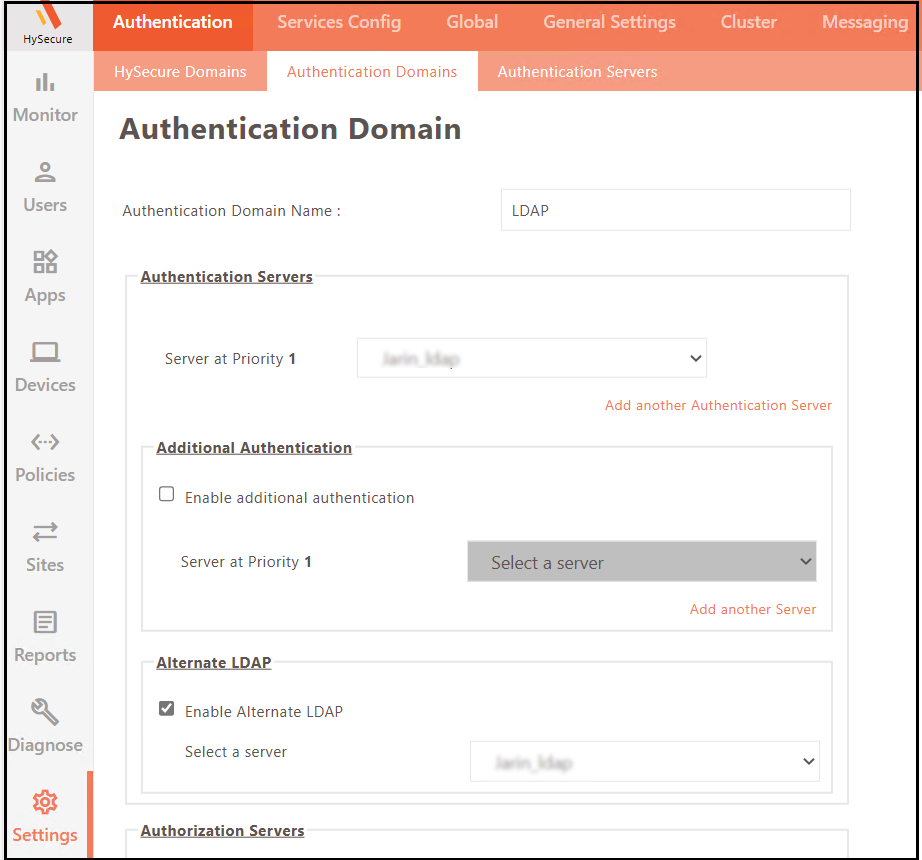KB009: Configure Alternate LDAP Server
Article ID: KB009
Last Updated: June 21, 2025
Applies To: HySecure Gateway 7.1 and above
Category: Security & Authentication Enhancements
Overview
This guide explains how to configure an alternate LDAP server specifically for password change requests. This feature allows password change operations to be directed to a different LDAP server than the one used for authentication, reducing load on the primary authentication server and improving system performance.
Prerequisites
- HySecure Gateway 7.1 or higher
- Security Officer or Administrator access to the HySecure management console
- Primary LDAP/Active Directory server configured for authentication
- Secondary LDAP server available for password operations
- Network connectivity to both LDAP servers
Benefits
- Load Distribution: Reduce load on the primary authentication server.
- Improved Performance: Better system efficiency through workload separation.
- Enhanced Availability: Separate password operations from authentication.
- Flexible Architecture: Support different LDAP servers for different operations.
Important Limitations
Scope of Alternate LDAP:
- Only applicable for password changes after user login.
- Self-Service Portal requests still use the primary authentication server.
- Does not support self-service functions (account unlock, forgot password).
Use Cases:
- Post-login password changes via the HySecure client.
- Post-login password changes via the HyLite portal.
Procedure
Step 1: Configure Alternate LDAP Server
-
Access Management Console
- Log in to the HySecure management console as a Security Officer or Administrator.
-
Navigate to Authentication Servers
- Go to Settings > Authentication > Authentication Servers.
-
Add Alternate LDAP Server
-
Click Add to create a new authentication server.
-
Configure alternate LDAP server details:
-
Server name and description
-
LDAP server address and port
-
Bind credentials for password operations
-
SSL/TLS settings if required
-
-
Test the connection to verify the configuration.
-
Save the server configuration.
-
Step 2: Configure Authentication Domain
-
Navigate to Authentication Domains
- Go to Settings > Authentication > Authentication Domains.
-
Edit Existing Domain
-
Select the authentication domain with the primary authentication server.
-
Click Edit.
-
-
Enable Alternate LDAP
-
Find the section Alternate LDAP.
-
Enable the Alternate LDAP option.
-
Select the alternate server from the dropdown menu (configured in Step 1).
-
Click Submit to save changes.

-
Monitoring and Logs
Authentication Logs:
-
Monitor authentication events in user logs.
-
Verify primary server handles login requests.
-
Confirm alternate server handles password changes.
Performance Monitoring:
-
Monitor load on the primary authentication server.
-
Check performance improvements after the configuration.
-
Track password change operation success rates.
Architecture Considerations
Server Roles
Primary Authentication Server:
-
Handles user login authentication.
-
Processes MFA requests.
-
Manages user authorization decisions.
-
Supports self-service portal operations.
Alternate LDAP Server:
-
Processes password change requests only.
-
Reduces load on primary server.
Network Requirements
Connectivity:
-
The HySecure gateway must reach both servers.
-
Network latency considerations for user experience.
-
Firewall rules for both LDAP servers.
-
Redundancy planning for both servers.
Data Synchronization
Password Consistency:
-
Ensure password changes sync between servers.
-
Configure appropriate replication intervals.
-
Monitor synchronization status.
-
Plan for synchronization failures.
Troubleshooting
Common Issues:
Password Changes Failing:
-
Check: Alternate LDAP server connectivity.
-
Verify: Service account permissions on alternate server.
-
Test: LDAP bind operations manually.
-
Review: Password policy compliance.
Authentication Issues After Password Change:
-
Cause: Password synchronization delay.
-
Solution: Wait for replication to complete.
-
Check: Replication status between servers.
-
Verify: Password change completed successfully.
Performance Not Improved:
-
Check: Network latency to the alternate server.
-
Monitor: Primary server resource utilization.
Configuration Not Taking Effect:
-
Verify: Alternate LDAP is enabled in the domain configuration.
-
Check: The correct alternate server is selected.
-
Test: Configuration with a specific user account.
Diagnostic Steps
Connectivity Testing:
# Test primary LDAP connectivity
ldapsearch -H ldap://primary-server:389 -x -D "cn=service,dc=domain,dc=com" -w password
# Test alternate LDAP connectivity
ldapsearch -H ldap://alternate-server:389 -x -D "cn=service,dc=domain,dc=com" -w password
Log Analysis:
-
Check HySecure authentication logs.
-
Review LDAP server logs for both servers.
-
Monitor network connectivity logs.
-
Analyze user session logs for password changes.
Security Considerations
Access Control
Service Accounts:
-
Use dedicated service accounts for alternate LDAP.
-
Grant the minimum required permissions.
-
Regular password rotation for service accounts.
-
Monitor service account usage.
Network Security:
-
Encrypt connections to both LDAP servers.
-
Regular security assessments.
Audit and Compliance
Logging Requirements:
-
Log all password change operations.
-
Track which server handled each operation.
-
Maintain an audit trail for compliance.
-
Regular log review and analysis.